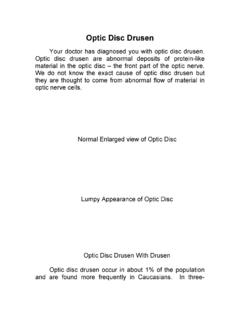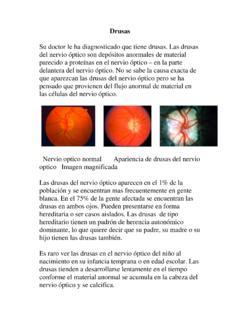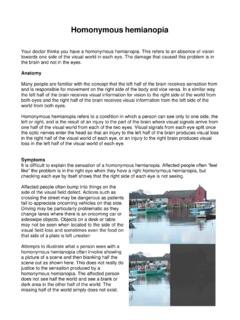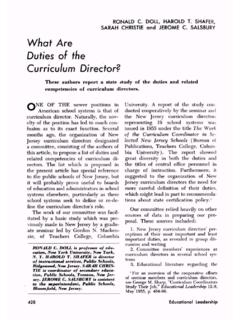Transcription of NEURO-VESTIBULAR EXAMINATION
1 NEURO-VESTIBULAR EXAMINATION David E. Newman-Toker, MD, PhD The Johns Hopkins University School of Medicine Baltimore, MD Syllabus Contents 1. Head Impulse Test (pp 1-3) 2. VOR Cancellation Test (pp 4-6) 3. Dix-Hallpike Test (pp 6-8) 4. Modified Epley Maneuver (pp 9-10) 5. References (pp 11-12) Head Impulse Test ( VOR Gain) What Overview of the Test It has been known for over a century that the eighth cranial nerve conveys balance information to the brain, but until the late 1980s, there was no clinical method available to effectively test for vestibular hypofunction in awake patients at the bedside. For many years, comatose patients had been examined using oculocephalic maneuvers (commonly referred to as doll s eye maneuvers) or caloric testing to interrogate the vestibular system in coarse fashion at the bedside, without the need for special equipment.
2 However, this was used principally to determine whether the pons was grossly intact or irrevocably damaged. Similar non-quantitative caloric testing could also be performed in awake patients with suspected vestibular disease, but an intact response was generally the norm. Partial or relative vestibular hypofunction could only be measured in a laboratory-type setting, using quantitative electro-oculography (EOG) as part of the caloric electronystagmogram (ENG). The doll s eye maneuver in awake patients generally produced no useful results that correlated with quantitative caloric weakness. In retrospect, the principal problem was that the test was not challenging enough for the vestibular system.
3 In 1988, the horizontal head impulse test (h-HIT) of vestibulo-ocular reflex (VOR) function was described by Halmagyi and Curthoys as a bedside test for peripheral vestibular This high-acceleration maneuver (which we might think of as doll s eyes on steroids ) proved to be capable of identifying those with vestibular failure in a way that the classic oculocephalic maneuvers could not. Moreover, it became clear that the test was able to interrogate each ear separately, likely due to a quirk of normal vestibular physiology where excitatory responses carry more weight than inhibitory ones. This directional asymmetry in vestibular responses of the healthy labyrinth is known to neuro -otologists as Ewald s second law.
4 Since its original description, an abnormal h-HIT has repeatedly been shown to correlate with ipsilateral vestibular hypofunction, and, more specifically, to correlate with de-afferentation of the inputs from the ipsilateral horizontal semicircular Although not described in detail here, clinicians should be aware that the h-HIT has since been adapted for use to interrogate function of the two vertical semicircular canals (anterior [a-HIT] and posterior [p-HIT]).3 A similar test using a linear head motion (the head heave test) has also been developed to interrogate function of the linear-acceleration-detecting otolith organs (utricle and saccule).
5 5 How Method of the Test The horizontal head impulse test (h-HIT) of vestibulo-ocular reflex (VOR) function, as originally described, is a rapid, passive head rotation from a center to lateral (10-20 degrees) position as a subject fixates at a central target ( , the examiner s nose). Since the response is linked to high acceleration rather than high velocity or amplitude of the head rotation, the technique is properly conducted with a quick flick of the examiner s wrists over a very short amplitude. The examiner must warn the patient that the head will be rotated very rapidly, and it is generally advised to rotate the head slowly several times before conducting the high-acceleration maneuver.
6 NEURO-VESTIBULAR EXAMINATION David E. Newman-Toker, MD, PhD Page 2 of 12 The normal VOR response to a rapid, passive head rotation as a subject fixates on a central target is an equal and opposite eye movement that keeps the eyes stationary in space (negative h-HIT). This is sometimes referred to as a VOR gain equal to (ratio of head rotation to eye rotation 1:1). An abnormal response occurs when the head is rapidly rotated toward the side of a vestibular lesion. The loss of vestibular afferent input results in the inability to maintain fixation during the head rotation ( gain < ), requiring a corrective gaze shift (re-fixation saccade) once the head stops moving to re-acquire visual fixation on the central target (positive h-HIT).
7 A large-amplitude re-fixation saccade indicates a very low VOR gain and substantial vestibular hypofunction. A common adaptation of the h-HIT is to displace the head laterally first, then rotate the head back to the center position. Although not originally validated with a lateral to center rotation, there is no compelling reason to believe that the results should differ appreciably, since the VOR response is largely independent of the starting position of the head on the neck. Some examiners find the maneuver easier to conduct using this centripetal head motion, and the results are often easier to interpret (since the globes end in the primary position in the orbit, rather than a somewhat laterally-displaced position).
8 Using a centripetal head rotation also reduces any theoretical risk of vertebral artery injury with neck over-rotation by an overzealous, inexperienced examiner. Note that for the test to work effectively, the patient must be able to fixate steadily on a visual target. This means that if they are visually impaired ( , blind, severe refractive error without glasses or contact lenses), cognitively impaired ( , comatose, inattentive), or otherwise unable to consistently follow directions ( , 2 years old or with a language barrier and no interpreter), then the test cannot be performed. Even awake, alert, and attentive patients must often be reminded to maintain visual fixation during the testing; intermittent attentiveness can result in extraneous re-fixation saccades that can be misinterpreted ( , false positives).
9 Why Purpose of the Test The h-HIT interrogates the VOR s disynaptic reflex arc that extends from the horizontal semicircular canal, through the vestibular nerve, into the lateral pons ( vestibular nucleus), and from there to the 6th nucleus (and corresponding outputs to the horizontal extra-ocular muscles). The test is abnormal with lesions affecting the labyrinth ( , labyrinthitis or aminoglycoside ototoxicity), vestibular nerve ( , vestibular neuritis or surgical section), and lateral pons ( , AICA stroke or multiple sclerosis plaque). The h-HIT cannot be used to assess VOR function in the presence of a 6th nucleus lesion or paralysis of horizontal extra-ocular muscles.
10 When Uses of the Test There are three principal uses of the test, all focused on confirming a peripheral (as opposed to central), cause of vestibular or vestibulo-visual symptoms: 1. Acute vestibular syndrome Patients presenting acutely with severe vertigo, spontaneous nystagmus, nausea or vomiting, head motion intolerance, and gait unsteadiness that has persisted for more than 24 hours have what is known as the acute vestibular syndrome. 6 This syndrome is most often the result of an acute peripheral vestibulopathy known variably as vestibular neuritis (without auditory symptoms) or labyrinthitis (with auditory symptoms). However, some patients instead harbor dangerous stroke The most common stroke mimic is an inferior cerebellar stroke in the PICA territory which produces a pseudoneuritis Since the three-neuron horizontal VOR arc does not traverse the cerebellum (nor the lateral medulla), PICA strokes mimicking vestibular neuritis can be differentiated from true vestibular neuritis on the basis of a normal ;12 Note that an abnormal h-HIT could result from neuritis or a lateral pontine stroke.















